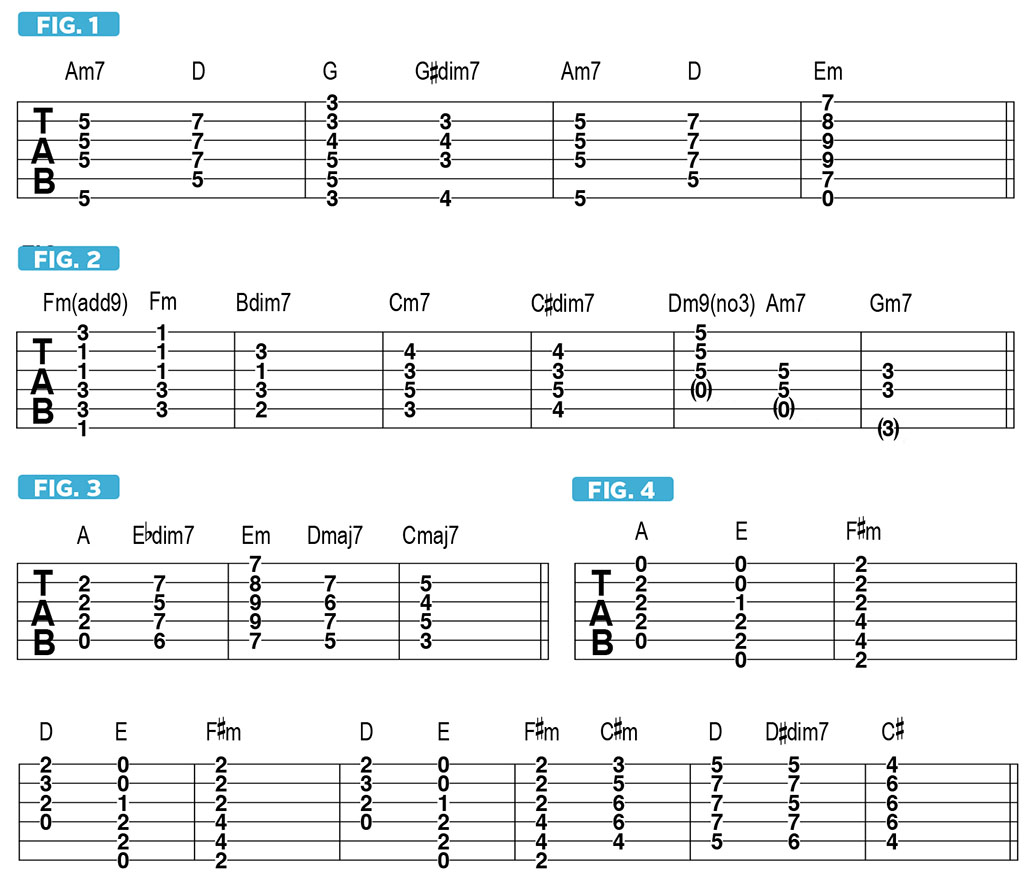More Tasteful Examples of How Dim7 Chords Are Used
A few examples from the rock and pop catalog of how famous composers have successfully harnessed this enigmatic chord to great effect.
In the previous lesson, we looked at ways in which great pop songwriters have tastefully employed the “spooky” diminished seven chord (dim7), which is spelled, for all intents and purposes, root, minor third, diminished fifth, major sixth, or “1 b3 b5 6.” I emphasize the term tastefully because dim7 has a very restless, unstable quality that if held too long becomes downright obnoxious, as it begs to resolve to a more stable-sounding major- or minor-type chord. And so dim7 is almost always employed as a passing chord between two more stable-sounding entities, to create a satisfyingly bitter-then-sweet feeling of harmonic tension and release. I’d now like to cite a few more examples from the catalog of rock and pop music of how famous composers have successfully harnessed this enigmatic chord and put it to an effectively palatable use, similar to the way a master chef would sparingly use a powerful and potentially overwhelming spice to add just the right amount of zest to a recipe.
In the verse progression to “Bennie and the Jets,” specifically at 0:33, Sir Elton John used, on piano, a G#dim7 chord to pivot from the “one major,” G, to the “two minor,” Am7, using voicings similar to those depicted in FIGURE 1. By the way, this three-chord move — from one major to “sharp-one dim7” to two minor — is essentially the same as that heard in the beginning of “Friends in Low Places,” as recorded by Garth Brooks (a whole step higher), which we looked at in the previous lesson, and it has also been used in countless old jazz standards in a variety of keys.

Led Zeppelin’s Jimmy Page employed dim7 chords rather inventively, on an overdriven electric guitar, in the instrumental bridge section to “The Wanton Song,” using, initially at 0:59 into the track, the barre-chord voicings broadly illustrated in FIGURE 2. To these shapes, Page added a few little melodic embellishments and passing tones with his pinkie on either the B or high E string in between the “climbing” chords in the progression.
Page also used a dim7 chord in “Ten Years Gone,” in this case with a cleaner tone and the voicings illustrated in FIGURE 3. Interestingly, each time he plays Ebdim7 (first at 0:25), bassist John Paul Jones goes up to F#, a minor third above the Eb root, which works perfectly because it creates an inversion of the chord. As I pointed out last time, in reference to George Harrison’s use of dim7 chords in “My Sweet Lord” and Paul McCartney’s in “Michelle” by the Beatles, due to the chord’s symmetrical, “stacked-minor-thirds” interval structure, Ebdim7, F#dim7, Adim7 and Cdim7 are essentially the same chord, in four different inversions, as are Edim7, Gdim7, Bbdim7 and C#dim7. The same holds true for Fdim7, Abdim7 (a.k.a. G#dim7), Bdim7 and Ddim7. So there are really only three unique dim7 chords, the other nine being inversions of those three!
Another great example of the use of a dim7 chord in a classic rock song can be found in the verse progression to “For Yasgur’s Farm” by Mountain, where, initially at 0:27, guitarist Leslie West goes from D to Ebdim7 to C#. FIGURE 4 shows the basic changes leading up to this pivotal and hauntingly beautiful harmonic moment. Similar to what Jones did in “Ten Years Gone,” Mountain bassist Felix Pappalardi makes good use of the symmetrical dim7 inversions and goes down to C below West’s Ebdim7 chord, which essentially makes the chord Cdim7, and creates a nice-sounding root motion of D to C(dim7) to C#. When strumming these changes, listen to the way each note, or “voice,” moves up or down to its counterpart in the next chord on the same string.
Next time, we’ll look at some musically interesting “melodic extensions” that may be added to the top note of a dim7 chord voicing to broaden its usefulness and appeal.
Senior Music Editor "Downtown" Jimmy Brown is an experienced, working guitarist, performer and private teacher in the greater NYC area whose professional mission is to entertain, enlighten and inspire people with his guitar playing.
Get The Pick Newsletter
All the latest guitar news, interviews, lessons, reviews, deals and more, direct to your inbox!
Over the past 30 years, Jimmy Brown has built a reputation as one of the world's finest music educators, through his work as a transcriber and Senior Music Editor for Guitar World magazine and Lessons Editor for its sister publication, Guitar Player. In addition to these roles, Jimmy is also a busy working musician, performing regularly in the greater New York City area. Jimmy earned a Bachelor of Music degree in Jazz Studies and Performance and Music Management from William Paterson University in 1989. He is also an experienced private guitar teacher and an accomplished writer.








![Joe Bonamassa [left] wears a deep blue suit and polka-dotted shirt and plays his green refin Strat; the late Irish blues legend Rory Gallagher [right] screams and inflicts some punishment on his heavily worn number one Stratocaster.](https://cdn.mos.cms.futurecdn.net/cw28h7UBcTVfTLs7p7eiLe.jpg)


